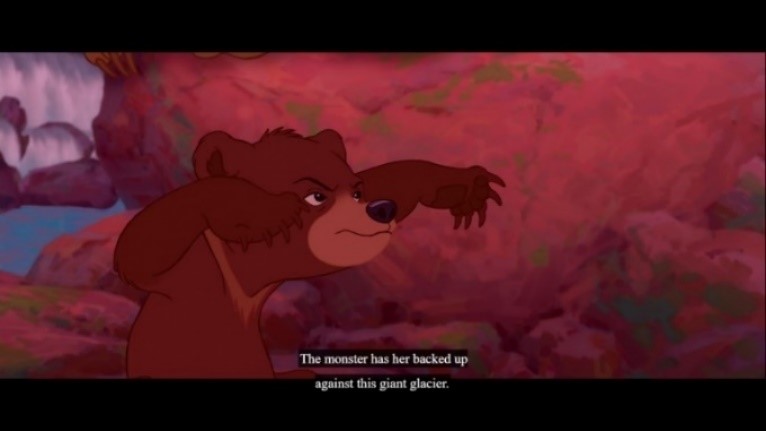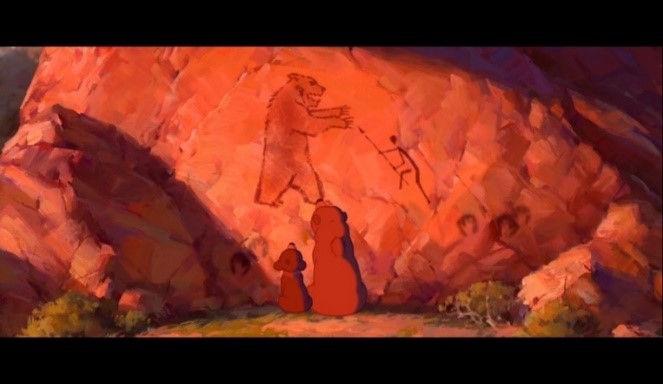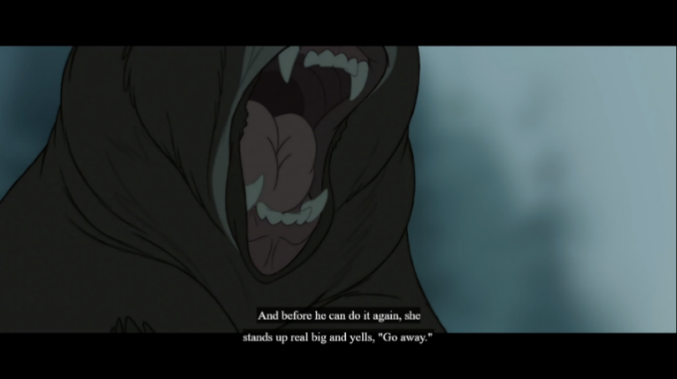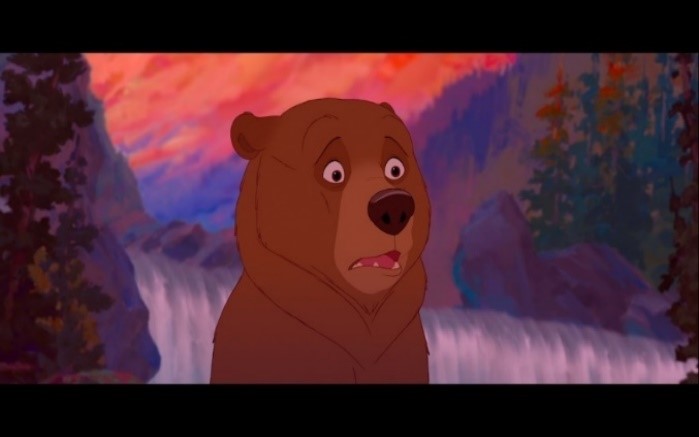Brother Bear works to trouble the relationship between humans and bears through destabilising the idea that bears are inherently threatening and monstrous. The children’s animation follows Kenai, a young human boy who is transformed into a bear by spirits after killing a bear to avenge his brother’s death.
Within this scene, Blaise and Walker use parallel editing to create a flashback to a scene earlier in the film, reimagining the struggle between human and bear from a new perspective. Whilst the initial scene situated the bear as the aggressor, the narrative is reframed through Koda’s narration, bringing Kenai to the realisation that the bear he killed was not a monster, but the mother of Koda, his newfound younger brother figure. Koda’s storytelling triggers Kenai’s flashback to his own involvement in the bear hunt. A close-up shot frames Kenai’s panic as through a virtual camera movement, the background rapidly retreats and enters the grayscale world of the past. The chaotic flashback is dramatized through overtly artificial jump cuts. The cuts are emphasised by a flashing technique which further disturbs the continuity between Koda’s story and Kenai’s memory.
Koda dramatizes, ‘the monster has her backed up against this giant glacier’. The human is the monster here, thus subverting the human discourse of the film which repeatedly brands the bear as a senseless monster. This concept is played with throughout the film, offering an alternative perspective to anthropocentrism. Whilst Koda’s melodramatic actions are intended to replicate the threatening stance of the human hunter, ironically, they more closely resemble a human depiction of a threatening bear, as echoed in the human cave markings earlier in the film. Blaise and Walker use this to foreground the contrasting perceptions of danger across species, thus challenging existing stereotypes of bears as dangerous and predatory.

Koda imitating a monster 
Cave markings
Furthermore, unlike the original depiction of the hunt, in Koda’s flashback we can understand the language of the bear. Koda narrates, ‘she stands up real big and yells “go away”’. Here, the previously indecipherable roar becomes a plea for mercy. Koda continues, ‘There is a whole pack coming right at her’. The perception of threat is reversed, through the animalised language of ‘pack’, revealing the human as the aggressor. Moreover, Kenai’s own voice proclaiming, ‘I’m going after the bear’, is juxtaposed against the concerned feminised voice of Koda’s mother. Koda’s mother’s parental concern is starkly opposed with Kenai’s boyish aggression, once more depicting the man as a thoughtless killer, rather than the bear.

‘Go away!’ 
Kenai’s realisation
The cutting speed increases alongside an intense drumbeat as the scene speeds towards Kenai’s realisation that he has killed Koda’s mother. The shot returns once more to real time, framing Kenai’s heaving shoulders and open-mouthed shock. This panic-stricken reaction is humanised, blurring the two sides of Kenai’s consciousness. (insert figure 4)
Blaise and Walker use this flashback to undermine the film’s initial representation of bears as monstrous creatures. Through reframing the human as the monster, Koda’s narrative successfully challenges an anthropocentric discourse. The scene encourages human culpability and reveals the predatory potential of the human being, through revealing that Kenai’s killing of the bear was intentional, however the killing of the man by bear was not.